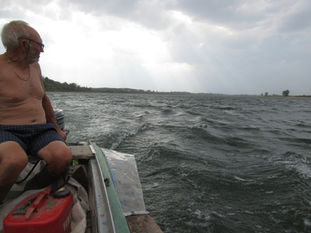
Chorus howling which was the topic of the previous blog, belongs to what my father calls ‘long-range vocalization.’ This is when jackals want their voices to carry over long distances. According to his estimations: of up to four kilometres.
Why should jackals want to be heard so far? A major reason seems to be connected with inter-group rivalries over a high-yielding and stable food resource (a ‘focal resource’). A rival group howls towards such a place wanting to see whether its ‘hosts’ (the group nearest to the resource) are around it. In case the hosts are there, these last answer back as a group. In case they are not, the rivals make use of their absence.
For these long-range vocal duels to happen, jackals need good acoustics in the wide concert-hall of their range. They do not like noises which reduce the quality of such acoustics: like that of rain and strong wind. Loud music that humans like so much for their picnic parties is also irritating.
Sounds carry well over water. Although the river is about 800 – 1 km wide at Km 727, relative to water-level, a boom-box on the Romanian bank is heard as if one is sitting right next to it.
The jackals (together with my father and I) do not like this. It is like the neighbours having a loud party all night long. (At great religious festivals, like Virgin Mary’s Day (14 August) picnic parties on the Romanian bank may last for up to three days. Loud music is played until 2 a.m. and then resumed at 6 a.m.). In a city one calls the police but who is to call here? Luckily, such parties get going only twice over the whole summer – on St.Eliah’s Day (Ilinden, 2 Aug.), and the above-mentioned Virgin Mary’s Day (Goliama Bogoroditsa). Smaller parties happen on week-ends, but are less traumatic.
Particularly irritating on such occasions are human imitations of howling, or playing tapes of pre-recorded howling. In such cases, the whole jackal scenario is changed beyond recognition: who are these jackals howling and why? Such imitations are better avoided as there are enough human disturbances as it is: like the heavy traffic in the river and up in the air, changing time from astronomical to DST and back, and a host of other nasty things.
Jackals have a great liking for complete silence. They like to hear well and for other jackals to hear them. As when a lone jackal is exploring a new territory and is in search of a mate to start their own family: then he would like to be heard from as far as possible. A lone wail may also be a signal from a senior adult in search of the young of the family. In Boldy’s family, White Back – the ‘Uncle’ – is often heard to be doing that (Jackal Voices).
Short-range vocalization
This is for communicating within the ‘core territory’. This last term describes the part of the whole foraging range which is immediately around the day resting place of the family and its vital centre: the birthing den. In an ideal case arrangement, the family home (day resting place plus den) is close to a focal resource, as also to water.
Such was the situation at Km 727. From river to home, the distance was 70 m at an average water-level of 220 cm. Along the bank, the side of the core-territorial rectangle can be put at 35 m: the distance from the ‘square’ in front of my father’s tent to the path up the bluff (the ‘Eastern staircase’). In sum, the core territory can be estimated to be of, roughly, 250 sq.m. Given that the entire foraging territory is of some 34 sq.km. it can be seen that the core territory is only a tiny part of it.
Communication within the core territory is either between members of the resident family (Boldy’s family in our case), or between the core-territorial ‘hosts’, on the one hand, and intruders from neighbouring families (‘trespassers’), on the other. In less common cases, family members address neighbours from other species. In our case, exchanges have been recorded to involve the (mostly) good-natured Badger Gosho, as well as the old (but terror-inflicting) wildcat.
Cackling and snorting are expressive of anger. As we can hear in Fig. 2, one or two senior adults are cackling and snorting at Badger Gosho, in protest about his monopolizing the bait-site. They are afraid of him, however, and their protest comes from a safe distance behind the bushes. Badger Gosho runs towards them to keep them there and then comes back to eat in (some) peace.
In Fig. 3, the mеоwing of a cat (maybe the Old Wildcat?) sets several family members howling in chorus, while they are retreating into the bush eastwards (to the right of the frame). The chorus in that particular case is an expression of indignation, mixed with fear.
In-group vocal signals are also used in the process of ‘disciplining’ the young. Youngsters (cubs and junior adults), are not allowed at the bait-site before a senior adult has satisfied his first appetite. Table etiquette requires that the lower ranks will wait in the ‘wings’ where the senior adult may decide to leave them a piece of food.
Infringements of the rule are reacted to by a range of signals. In the most flagrant cases, the senior rushes upon the youngster, growling:

In the particular case, there are two youngsters – Big Ears and his sister – who are circling around the bait-site. From the direction of the home path there comes White Back. Rushing at them and growling, he places them where they should be: in the wings. In a cut from the clip, we can see the scene of a guilty culprit scolded by an angry uncle:
At the other end of such angry scenes, there may be only a turning of the head and a look to make an obedient youngster assume their place in the wings:
Many other vocal signals can be heard in the core territory. What they signify is unclear at this stage of the research. We keep guessing. A clue to meaning is provided by context. Thus a possible meaning of vocalization (cackling and squealing) in the situation given below could sensing danger (‘Look – someone is there, let’s run!’). In the particular case, danger seems to be coming from the bluff:
A highly intriguing case is presented in the following clip. A trespasser is eating at the bait-site but he senses the presence of hosts on the bank. He beats it down my father’s path, left, which in itself is indicative of a trespasser’s status. Then Big Man with a youngster in tow rush to the bait-site in hot pursuit, sniffing around for the intruder’s tracks. At that moment, a signal like giggling is heard from the square where the trespasser could be expected to be. Could it be that he is taunting the pursuers? In response, Big Man advances some way along my father’s path, but does not seem willing to go much further. An amusing detail is that while all this is going on, a mouse is watching the show from the wings:
Apart from the multitude of vocal signals, jackals also use what linguists would call para-vocal communication. This is when signals are given not with voice, but with other instruments. It has been mentioned before, that a function of twigging may be provoking a hidden enemy to try and see who or what is making the noise and thus reveal themselves.
Possibly a variant of such a function of twigging is what my father calls ‘crashing’. As a technique it is very similar to pawing, except for it being done with front legs, rather than the hind legs. Done with the hind legs, it is an expression of defiance and posturing (See post 'On Trust and Distrust'). Crashing, on the other hand, has again a provoking function – like twigging. This is well-illustrated in the following clip. In it, Round Ears combines pawing with crashing of dry twigs, peering all the time to see how this works on a supposed hidden enemy.
My father says that crashing is often heard when there are visitors at the camp. He thinks that one or more of the family may want to see whether the new people are aggressive or not. Should they be of the first kind (impossible to happen around my father, but still), jackals know from experience with other groups on the bank that rocks may be hurled at them, or even guns fired.
In sum, the vocal (and para-vocal) repertoire of jackals is extensive. So far, we know only a small part of it, and much of what we know requires further proof. Many more hours (months, years) with the jackals need to be spent. The research is going on.






